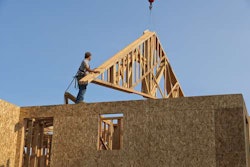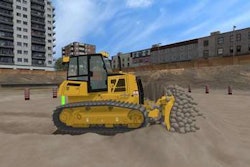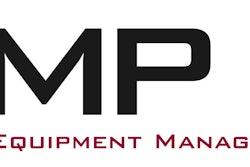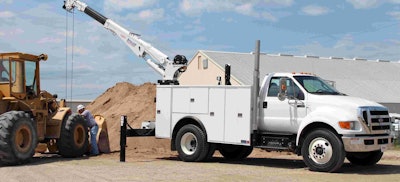
 Any telescoping service truck crane with lifting capacity within 2,000 to 14,000 pounds falls within the rules of the OSHA 1926 Subpart CC.
Any telescoping service truck crane with lifting capacity within 2,000 to 14,000 pounds falls within the rules of the OSHA 1926 Subpart CC.Editors note: Last week OSHA proposed to delay service truck crane operator certification from November 1014 to November 2017. We have edited the following article to reflect that change.
A complex new regulation is shaking up the world of small, truck-mounted cranes used to service construction machines and deliver building materials.
Until recently, cranes with a lifting capacity less than 14,000 pounds were exempt from oversight by the federal Occupational Safety and Health Administration. That changed when OSHA 1926 Subpart CC became law August 9, 2010. This governs any crane with a lifting capacity greater than 2,000 pounds. The regulation put a number of rules into effect immediately and initially set November 10, 2014 as a deadline for operators of service truck and building material delivery cranes to be certified.
In late May though, OSHA backed away from the 2014 certification deadline, proposing to extend it to November 10, 2017. But everything else in the new regulation remains in force.
Nonetheless, for safety and liability purposes many fleet managers are certifying their service truck operators. And even though OSHA won’t fine you for not having certified operators, you could be, as of August 9, 2010, be cited for not having “qualified” operators or failing to follow the rest of the regulations in play now.
What’s the difference between qualified and certified?
“Those two definitions run very close together,” says Dave Foster, training manager for VTS, the training division of crane company Venturo Manufacturing.
“Site supervisors are saying ‘I don’t care what OSHA says about you being exempt. If you are coming on my jobsite I want you to be a certified operator. If you’re not, don’t come on my site.’”
A company can qualify its employees with an internal training and testing program. Certification requires testing by an accredited outside testing company done to a national standard test. By the letter of the law you could do some quick and dirty training and testing and claim your service truck operators are qualified. But done right, training and testing for either should be almost identical, Foster says.
One major point of difference is that a certified service truck crane operator gets a card and can take that credential with him to other employers. It’s a portable asset, like a CDL. A qualified operator is only qualified to work at the company that gave him the training and testing. He can’t later go to a different company and claim to be qualified to run their service truck cranes.
As if that wasn’t complex enough, OSHA’s rules get deep into the weeds with definitions of what types of work and what types of small cranes require qualified (and eventually certified) operators.
Current provisions of OSHA 1926 Subpart CC already in place
When OSHA put the new regulations into effect in 2010, some provisions became law immediately. These primarily had to do with having qualified riggers and signal people, observing the new power line distance rules and being able to document equipment inspections. The list below gives a good indication of what you and your service truck operators are responsible for now, and what kinds of violations OSHA is currently writing citations for:
OSHA’s Top 10 crane standards cited:
- Signal person is not qualified.
- Materials are not rigged by a qualified rigger.
- No documentation available for the signal person.
- No annual inspections performed by a qualified person.
- No determination for working radius closer than 20 feet to a power line.
- Operator’s manual, load charts, hazard warnings, etc., not in the cab at all times.
- A determination for safety was not made by a competent person after a deficiency was noted during a visual inspection.
- Monthly crane inspection results are missing or signed documentation is not maintained.
- Inspections not performed annually by a qualified person or as specified.
- Labels supplied by manufacturer are missing.
What types of work are excluded from the regulation?
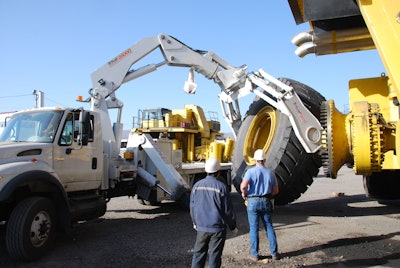 Replacing a used tire on a piece of equipment will not require a qualified or certified operator. Putting a new tire on a new piece of equipment may.
Replacing a used tire on a piece of equipment will not require a qualified or certified operator. Putting a new tire on a new piece of equipment may.“If you are doing anything relative to service and repair on a construction site, OSHA says you’re exempt,” says Tim Worman, business development Manager at IMT. “If you are using that same truck for any kind of construction you have to be a qualified or certified operator.”
Here’s where it gets tricky. By OSHA’s definition of “construction,” if you lift and place a new HVAC unit on a pad or the roof of a new building, that work is considered in-scope and you have to be certified to do so. If you take that same HVAC unit off the building to service or repair it, that work is out of the scope of the regulation. Likewise, if you put a new propane tank or a new electrical transformer on a concrete pad, you are in scope. Repair the same tank or transformer—using exactly the same equipment and processes—and that is considered service and repair work and you are out of scope.
“Most of our customers think they are in the service and repair business. Most of them are mechanics,” says Tim Davison, product manager bodies and cranes for Stellar Industries. “But the rules aren’t entirely clear. Under OSHA’s definition, if he is assembling a big shovel or truck at a mine site for the very first time, that could be considered construction and the operator would need to be qualified or certified.”
The rules for material delivery truck cranes
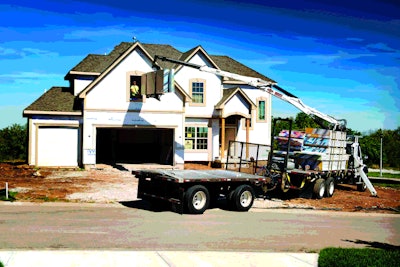 You don’t need a certified operator to place construction materials if you have a knuckleboom crane with automatic overload protection, a fork or cradle assembly and you are positioning sheet goods or packaged goods.
You don’t need a certified operator to place construction materials if you have a knuckleboom crane with automatic overload protection, a fork or cradle assembly and you are positioning sheet goods or packaged goods.Lumber and construction material delivery truck cranes are also now regulated under OSHA 1926 Subpart CC.
According to Regina McMichael, president of the Learning Factory, who conducts webinars on OSHA 1926 Subpart CC and how it affects building material deliveries, operators can get exclusion from the certification requirements if their cranes meet certain requirements. And they still have to follow the same rules as to what constitutes construction or assisting in construction.
At its very simplest, says McMichael, if the driver of a lumber or building materials truck uses his crane to drop trusses, structural steel, concrete elements or prefabricated components on the ground without arranging them in a sequence to facilitate further hoisting, he doesn’t need to be certified or meet any equipment requirements.
If however, he puts materials on the structure, stages, positions, holds or maneuvers the load in a way that assists the construction process he must either be certified, or meet specific equipment and material requirements, which are:
- The crane must be an articulating, knuckle-boom type.
- It must be equipped with a fork or cradle assembly.
- It must have an automatic overload protection device.
- The materials the operator positions on the structure or site must be sheet goods (drywall, plywood) or packaged goods such as roofing felt.
If material delivery does not involve placing material on the ground, or when hoisting, the equipment does not meet the four requirements above, operators of material delivery truck cranes must be qualified or certified, and must also currently comply with the provisions of the regulation that are in force now.
 Operators doing only service and repair work will not need to be qualified or certified.
Operators doing only service and repair work will not need to be qualified or certified.
How is this going to play out in the real world?
“There is a lot of gray area,” Worman says. And that has some site supervisors thinking proactively.
“Site supervisors are saying ‘I don’t care what OSHA says about you being exempt. If you are coming on my jobsite I want you to be a certified operator. If you’re not, don’t come on my site.’ They are taking that approach to protect themselves,” Worman says.
Another concern is that the drivers and operators of service truck cranes may be asked by construction crews to do a favor, to move a steel beam or a rebar bundle. Normally that’s not a problem, but under the OSHA rules any crane work that holds, supports, stabilizes, stages, sequences, or positions materials or aids or assists in the construction process, is considered in scope and requires a qualified or certified operator except when using very specific, exempt crane equipment.
How are different industries reacting to the new rules?
Given that there are thousands of unique construction applications, OSHA has been swamped with requests for clarification of the rules. By some estimates the agency has received more than 200 requests for letters of interpretation.
Of these only about 20 have been answered, says Joel Oliva, manager of test development and administration, National Commision for the Certification of Crane Operators. “You can read the agency’s responses on their website. And the truth is, the ones that have been answered often leave people asking more questions than answers.”
OSHA has so many requests for letters of interpretation that if you send one in right now it may be two years before you get a reply,” Worman says.
The propane industry is requesting exemption, as are the railroad, telecommunications and other industries. Thus far these industries have yet to get their exclusions. One of the few that has succeeded is the National Concrete Burial Vault Association. And the utility industry has applied for a fairly large exclusion for digger derricks, Oliva says.
One group that has gone in the opposite direction and embraced the rules is the outdoor sign industry, the people who put up billboards, says Oliva. “Instead of lobbying against it, they spent their money on developing training programs and are doing a wonderful thing for their people. And it’s going well,” he says.
How does training and certification work?
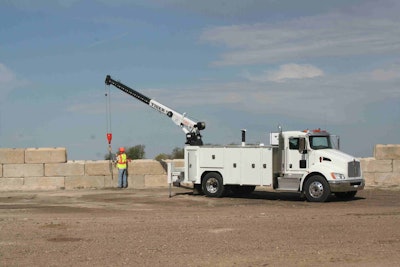 Any application that can be considered new construction will require a qualified or certified operator or meet specific crane and material requirements.
Any application that can be considered new construction will require a qualified or certified operator or meet specific crane and material requirements.On April 30, NCCCO officially launched its testing and certification program for service truck crane operators. There is a written test and a hands on test required for certification. The written test covers four areas, Oliva says:
- Site and set up
- Operations, things like knowing where components on the truck are located, what a winch does, what a snatch block is.
- Technical knowledge of the standards, codes, the requirements for the equipment and certifications.
- Understanding and interpreting load charts.
Of those four, the load chart section is likely to be the most challenging, Oliva says. “A lot of these folks don’t know how to read the load charts, but they need to.”
“A lot of these folks don’t know how to read the load charts, but they need to.”
The practical or hands-on portion of the test involves operating a crane through an obstacle course.
When asked if an experienced service truck operator could pass the test without training, Worman and Davison said probably not.
“Some will pick it up quick and some will struggle,” Worman says. We recommend you go to a training session before you take the test.”
“At the end of the day it helps them become better operators,” Davison says. “Education is never a bad thing. There are things in the test that our customers need to know, but if not studied they’re not commonly known.”
The NCCCO only writes the test and accredits the practical examiners who can administer the practical exams, but on its website you can find the names and contact information of private training companies who can train your personnel for the exams. Upon passing the test your operators will be issued a card with the designation STC.
“The TSS certification goes well beyond what the service truck crane operator needs to know,” Oliva says. So instead of designing a new certification program, the NCCCO got together with a group of service truck crane stakeholders and over a nine-month period hammered out a restricted certification program. The STC on the card means the holder is only certified to work with service truck cranes, like a restriction on your driver’s license.
How involved is the training and how much will it cost?
 Operators who pass a written and hands-on test will receive a certification card with the designation STC on it.
Operators who pass a written and hands-on test will receive a certification card with the designation STC on it.Different training organizations will have different class configurations a typical training process might take two or three days of classes, 16 to 20 hours of classroom time and cost around $800 to $1,000. The cost for the testing certified by NCCCO will be $165 for the written test and $60 for the practical test, Oliva says.
The TSS-STC card is good for five years, at which time the operator must take a written recertification written test to remain certified.
When OSHA issued its final rule, it had a provision requiring employers, rather than employees, pay the full costs of training and testing operators.
Who pays the fine for violations?
OSHA is set up to protect employees, so they only fine employers. Oliva says the new rules do not say that you as an operator are required to be certified, or qualified but rather they say that employers must insure that their operators are certified. uWhat remains uncertain is which employer will get fined, if say, a service truck crane operator shows up on site to work on a machine and gets talked into moving a bundle of rebar. Does the dealer or rental house take the hit, or the construction company running the site, or both?
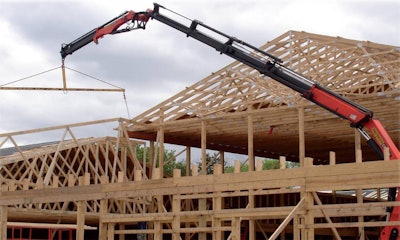 Setting trusses is considered new construction and since they are not sheet goods or packaged goods this job requires a qualified or certified operator.
Setting trusses is considered new construction and since they are not sheet goods or packaged goods this job requires a qualified or certified operator.Does the OSHA reg supercede state regulations?
States are allowed to set their own regulations regarding certification of crane operators. There are currently 17 states that regulate service truck cranes, Oliva says, many of them more detailed and restrictive than the OSHA rules. Regardless of the new OSHA regs, you will have to continue to comply with any and all state requirements for training, inspections, certifications and qualifications.
Certification an easy choice
While you could study the rules and configure your applications so that your service truck crane operators are exempt from the ruling, Worman and Davison say that strategy is risky.
“I’m seeing a lot of fleets getting their guys qualified,” Foster says. “They realize they need to do something other than just throw the guys some keys.”
Some details in the rules are still in limbo and many requests for letters of exception yet unanswered. Your operators may be tempted to skirt the law, and some vigilant supervisors are likely to keep uncertified operators off their sites. Given all this, the best route in most cases route is probably going to be certification, they say.
At a minimum you should hire a reputable training company to get your crews qualified. “I’m seeing a lot of fleets getting their guys qualified,” Foster says. “They realize they need to do something other than just throw the guys some keys. That way they can show OSHA the training that they did, the scores for their operators on the written and the practical, and that would normally satisfy OSHA. You’re doing a lot of the same things, but certification is just a bit more intense, more challenging. That’s the only difference between the two.”




